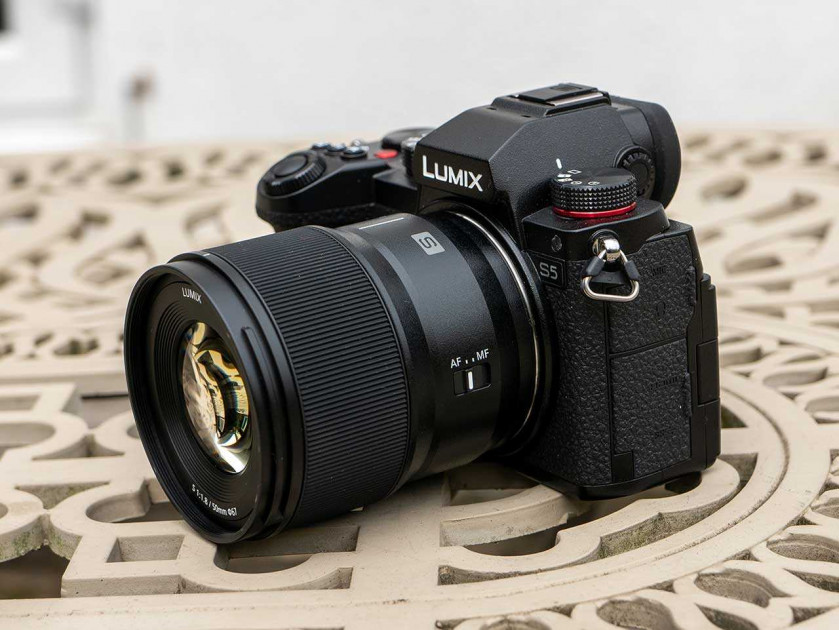Introduction
The ZV-E10 is the latest model in Sony’s range of APS-C sensor mirrorless cameras, joining the A6100, A6300, A6400, A6500 and A6600 in the current lineup.
A glance at the features of the ZVE10 shows that it shares much of its DNA with the A6xxx series cameras with their APS-C sensors, but it also inherits a lot of key features from last year’s vlogger-friendly ZV-1 compact camera.
Sony has cleverly combined the technology so that the ZV-E10 places a clear emphasis on video whilst still enjoying the benefits of the larger sensor size.
It features the same 24.2 megapixel APS-C sensor as all the other A6xxx series models, along with the latest BIONZ X image processor, rather than using the ZV-1’s smaller 1-inch sensor.
The Sony ZV-E10 can capture 4K HDR video at 30/25/24fps, along with Full HD 1080p content up to 120fps, both without any limits on the recording length. It also has the ability to shoot the same video Picture Profiles as its full-frame A7-series bigger brothers and features both 3.5mm mic and headphone ports and a built-in 3-capsule directional mic, complete with a clip-on wind-muffler.
The Alpha ZV-E10 has an auto-focus system with 425 phase detection and 425 contrast detection AF points that cover 84% of the entire image frame. This helps ensure accurate subject tracking, and with the aid of Sony’s powerful Bionz X image processor, gives the ZV-E10 a claimed focusing speed of just 0.02 seconds.
Furthermore, the Sony Alpha ZV-E10 offers real-time Eye AF for humans and real-time AF tracking with AI-based subject recognition, and the AF works in low-light down to -2EV.
Other key features include a fully articulating, vari-angle LCD monitor with touchscreen operation, 11fps burst shooting with continuous AF/AE tracking with the mechanical shutter and 8fps with the silent electronic shutter, live streaming support and Bluetooth connectivity.
The Sony ZV-E10 is available in black or white priced at approximately £680 / $700 body-only. It’s also offered as a kit with the E PZ 16-50mm F3.5-5.6 OSS lens, priced at approximately £770 / $800.
With some of the appealing features for stills photographers gone, but some great features for videographers added, just how easy is the ZV E10 to use as a photographer and as a videographer? Let’s find out…
Ease of Use
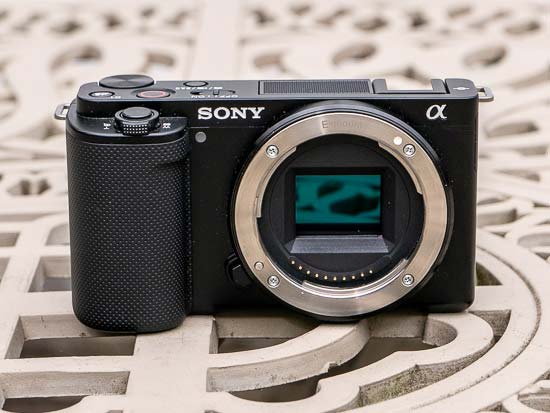 |
When considering the Sony ZV-E10 it’s important to understand exactly who it is aimed at. In a world of Instagram Stories, YouTube and TikTok, Sony has created a camera with a relatively large sensor that is designed to appeal to creators who want more quality and flexibility than they would get from shooting with a smartphone, action camera or even the ZV-1 compact with its smaller 1-inch sensor.
Externally, the new Sony ZV-E10 is extremely similar to the various A6xxxx cameras, so much so that at first glance you’d be hard-pressed to tell them apart side-by-side. It has some important differences inherited from the ZV-1 compact camera, though, that make it much better suited to video and vlogging.
It measures 115.2 x 64.2 x 44.8mm and weighs in at 343g with the battery and a memory card fitted, making it smaller and lighter than the A6400. Unlike that model, though, the Sony ZV-E10 doesn’t incorporate any level of weather sealing for extra peace of mind in inclement conditions.
It has a plastic, or polycarbonate, body, which has been chosen to keep the cost of the camera down, but in hand the body seems solid; all the components fit very nicely together, there are no creaks or weak looking joints, with everything very well designed and assembled.
Although not particularly deep, the sculpted hand grip is relatively wide and comfortable to hold on to, which combined with the sizable rear thumb rest makes the ZV-E10 feel secure enough even when shooting one-handed.
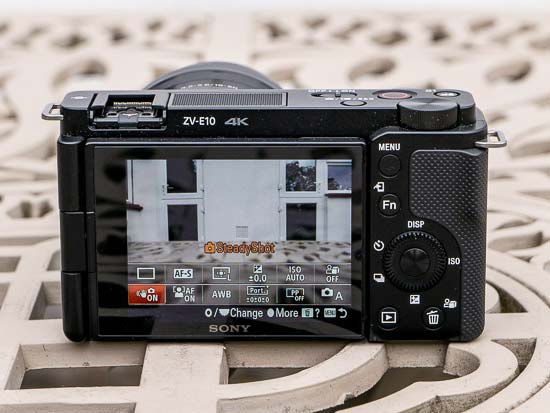 |
One of the main departures from the other A6xxx cameras is the omission of an electronic viewfinder in favour of the vari-angle LCD screen on the rear and 3-capsule directional mic on the top.
This is obviously a big compromise for stills photographers, less so for vloggers who will be more than happy using just the rear LCD screen to compose.
The ZV-E10 has exactly the same 3-inch widescreen LCD monitor with 922k resolution as the A6400, but this time it has a vari-angle design that’s hinged to the side of the camera. It can be flipped out to the side and rotated forwards by 180 degrees, making it perfect for vlogging and selfies. You can also fold it against the back of the camera to help protect it when you just want to carry the camera loose in a bag or pocket.
Sony have also implemented touch sensitivity on the screen, which makes functions like focus point selection much easier and more intuitive, especially given the lack of a rear AF joystick. Unfortunately, somewhat bizarrely you still can’t use the touchscreen to navigate the main menu or quick menu settings.
It’s on the top of the ZVE10 where there are the most notable differences from the A6xxx range. As mentioned above, the pop-up flash and electronic viewfinder are gone, replaced instead with a large three-capsule direction microphone and a Multi Interface hot-shoe.
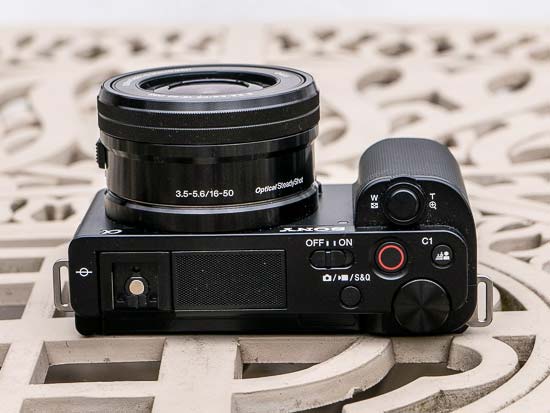 |
The shoe allows for any standard accessories to be mounted, with microphones and LED lights being the most obvious. However, the Multi Interface part allows for compatible to Sony accessories to work intelligently with the camera and also draw power where needed, which means that you can mount and use Sony flashguns.
Sony’s range of stereo microphones can also be used, with the audio sent through the Multi Shoe rather than requiring a 3.5mm cable to be plugged into the side of the camera.
Another big change is the removal of the traditional ‘Shooting Mode’ dial, which has been replaced with a Mode button on top of the camera with three options – Stills, Video and S&Q (slow-motion video). You then have to dip into the camera’s menu system to select, say, the Aperture Priority or Manual shooting modes.
The Slow and Quick (S&Q) mode gives you easier access to the camera’s slow- and quick- motion video options (frame rates from 1fps to 120fps), as selected in the Movie1 tab / S&Q Settings option in the main menu system.
The lack of a shooting mode dial may seem like a big change, but knowing photographers behaviour this is often a rarely used dial, which will largely be set in the same position depending on their preferred mode. It takes a few seconds longer to switch modes using the button and menu system, but it certainly isn’t a deal breaker unless you’re constantly changing between shooting modes.
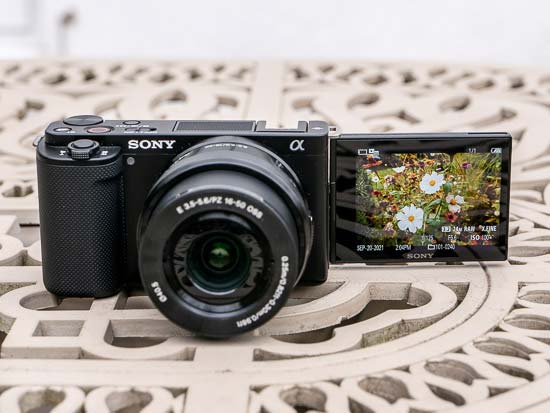 |
The top-plate also sees the addition of a large, recessed video record button. This is large enough to easily find in a hurry and is marked with a red ring to easily identify it against the shutter button.
The ZV-E10 even has a built-in zoom lever which encircles the shutter button. Although it only works with Sony’s Power Zoom lenses, it’s still quite a handy feature to have on such a video-centric camera, providing an alternative to using the zoom ring on the lens itself.
The Sony ZV-E10’s main exposure controls are virtually identical to those on the A6400. There’s the same dual wheel layout with a primary control dial on the top panel and a secondary rear-panel wheel that doubles up as the 4-way navigation buttons. It’s a reasonably ergonomic setup, though we’d still prefer an additional control dial positioned near to the shutter release, enabling simultaneous thumb and forefinger settings adjustment.
Finally on top of the camera there is a Background Defocus button. For vloggers the aim of this button is to switch between having the background blurred or clear. In photographic terms it is switching the aperture between the largest available for the attached lens and a stopped down value. It is a useful button to have available for video, but even for photography it is something I would use to make a quick aperture change.
And so on to the key part of the ZV-E10, its video features. As with the AF features, the ZV-E10 is like a miniature version of the A7 series cameras. Virtually all of the video settings that are found much further up in the range are here. Video can be recorded in 4K resolution at up to 30fps, whilst Full HD can be shot at up to 100/120fps depending on whether you are shoot PAL or NTSC format.
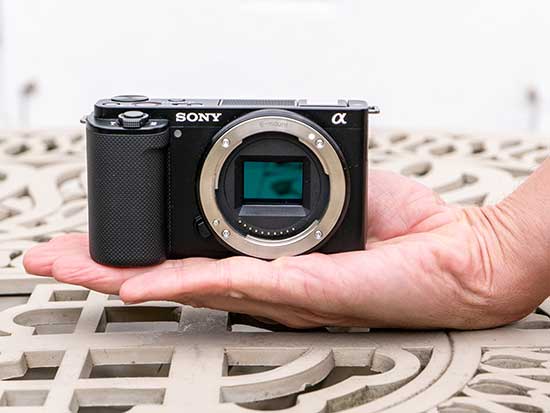 |
All of the Picture Profiles are present and correct, meaning you can match the footage shot with the ZV-E10 with cameras such as the A7 III, making it an ideal accompaniment for those who may be using those cameras in more of a studio environment. The ZV-E10 features Sony’s S-Log 2 and 3 gamma and HLG curves which enable it to record greater dynamic range, providing you’re prepared to colour grade the recording in post-production.
Proxy recording is also available, allowing low resolution 1280 x 720 resolution footage to be recorded alongside 4K or Full HD footage. This is great for those who may be editing video on older computers. Simply edit using the lower resolution proxy files, then switch to the full resolution 4K files when it comes to the fine-tuning and export.
A recording lamp (tally light) is also provided on the front face of the ZV-E10’s body for an at-a-glance indication of the current video recording status, and a red color recording alert square is displayed on the LCD screen too (both can be turned off).
Live streaming is possible directly from the ZV-E10 simply by connecting it to a computer or compatible mobile device via USB, eliminating the need for a video capture card. This allows the camera’s video and audio capabilities to be used for live social media and video conferencing. Both the UVC and UAC standards are supported for improved picture and sound quality during streaming.
A feature that Sony has unfortunately removed from the ZV-E10, which is present in the ZV-1, is an internal ND filter. On the ZV-1, this 3EV filter helps you to shoot at larger apertures on bright days, which is extremely useful when shooting video and trying to stick to the shutter speed being double the frame rate rule. On the ZV-E10 you’ll need to use actual glass filters mounted on the lens to get the same results.
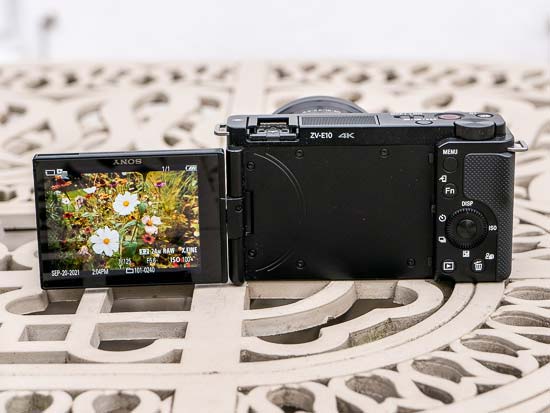 |
The rear of the camera is almost identical to the A6xxxx series, with the now familiar directional control dial placed around a central selection button. Around this sit 4 other buttons to access regularly used features.
The ‘Delete’ button also acts as the ‘C2′ custom button, which by default is set to access the Product Showcase mode. This is an autofocus mode that alerts the camera to switch focus from a person’s face to an object that may be held up in front of the camera.
It is a popular YouTube technique for when wanting to show an item to the viewer, but on cameras with slower autofocus it can leave the focus fixed on the presenter’s face with the product out of focus, and vice versa. The Product Showcase mode solves that issue, adding another plus point for vlogging with the ZV-E10.
By default, the Fn button activates the Sony ZV-E10’s Send to Smartphone Wi-Fi function when in playback mode. This works in conjunction with Sony’s Imaging Edge Mobile app and lets you transfer a full resolution JPEG image. Of course, you’ll have to connect your smart device first, but this is a pretty painless process. Sony lets you scan a QR code displayed on the ZV-E10’s monitor and this automatically enters the SSID password on your smartphone so you don’t need to type it manually.
Just like on the Alpha A6400 and the ZV-1, a low-power, low-bandwidth Bluetooth 4.1 data connection is available on the ZV-E10. This lets you connect your camera to a smart device even when the ZV-E10 is turned off for easier transfer of images. The Bluetooth connection can also be used to sync GPS location data from your smartphone.
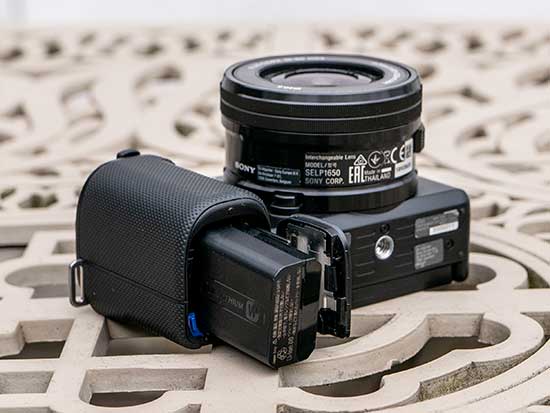 |
If you are familiar with the autofocus settings of the Sony A7 cameras you will be pleasantly surprised by the options found on the ZV-E10. Basically all of the AF features found on the recent A7 and A9 series cameras are present on the ZV-E10.
Where older A6xxx-series cameras featured 425 phase-detection AF points and 169 contrast-detection AF points, the ZV-E10 gets a whopping 425 points of both varieties, phase and contrast, again spread over almost the entirety of the sensor area (84% to be precise). This helps the camera achieve a quoted focusing time of just 0.02 seconds, compared to the 0.05 second time of the A6300 and A6500.
Another focusing feature that has been improved is Eye AF. It detects a human eye not only when shooting still images, but also when shooting video, and it works extremely well. It is visibly fast enough to follow an eye around the screen, and you can even select which eye you wish to focus on, just like on recent A7 cameras.
Firstly, Sony have implemented an algorithm that uses AI-based object recognition to detect and track the subject, improving the accuracy, speed, and performance of the continuous AF system. You simply select the the Tracking AF mode, position the AF point over the subject that you want to track, half-press the shutter, and the camera will doggedly follow that subject wherever it moves in the frame. It doesn’t have to be a person – the ZV-E10 will track virtually any subject that you care to point it at.
This also effectively means that you no longer have to activate Eye AF by holding down a custom button (although you still can if you want to). Instead simply half-pressing the shutter button whilst in the Tracking AF mode activates Eye AF automatically if it detects a face/eye, and it seamlessly switches back to non-specific subject tracking if the eye or face can’t be detected, then back again when it can.
 |
Conversely, you can use the system for easier composition of still subjects too. Simply focus on your subject, hold down the shutter button, and the camera will accurately lock onto your chosen subject while you recompose the frame, even if it’s in one of the furthest corners.
When turned on, the new Face-Priority in Multi Metering option adjusts the exposure to ensure that the detected face is exposed for correctly, which is perfect for scenes with very bright background conditions where typically the main subject would be under-exposed and too dark.
It’s fair to say that Sony’s real-time AF tracking is still something of a game-changer for both portrait and action photography – indeed, for any subject that you need to accurately and doggedly track, moving or otherwise. The ease of operation is a real eye-opener (excuse the pun) after years of holding down the Set button, and the sheer speed and adaptability of the system is surprisingly good in real-world use.
With regards to in-body image stabilisation (IBIS), unfortunately there isn’t any on this camera. Instead, you’ll have to use a lens with its own built-in stabilization system, such as the E PZ 16-50mm F3.5-5.6 OSS that we tested the ZV-E10 with. This will give you a couple of stops extra to play with when taking still images, and it will smooth out the lightest of movements when shooting video.
Failing that, you can also choose to use the camera’s Active SteadyShot mode when recording video (but not stills), which is a digital form of stabilisation. This crops in to the image slightly to give the camera the ability to digitally move the image frame around to compensate for any larger movements.
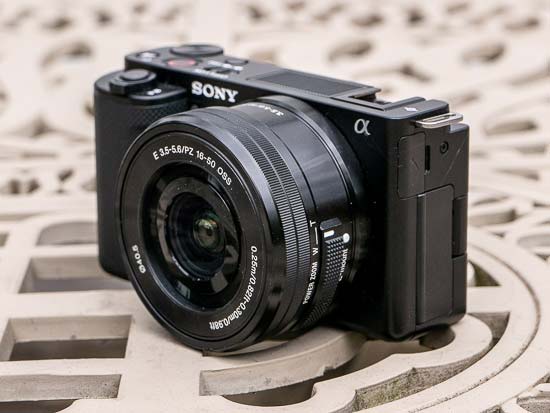 |
It works very well, creating very stable footage when handholding and taking out all but the heaviest of footsteps when walking. The catch is that because of the slight crop, if you are vlogging your face will appear larger when in the frame, so you’ll need to use a pretty wide lens. I would suggest only using this mode when walking or zooming in to show something, and when presenting to camera stick to using the lens’ stabilisation mode.
In addition, camera-shake metadata is recorded by the ZV-E10’s built-in gyro sensor, allowing handheld footage to be smoothed out and stabilised in post-production using Sony’s Catalyst Browse / Catalyst Prepare desktop application.
The ZV-E10 offers the same burst shooting capabilities as the A6400, with both cameras capable of shooting at 11fps using the mechanical shutter and 8fps using the electronic shutter with continuous AF/AE metering and almost no perceptible lag on the LCD. It can record 99 JPGs and 46 RAW files in a single burst.
The Sony ZV-E10 uses the latest menu design from the Alpha A7-series cameras, rather than the one found on the A6500 and A6300. It has a more logical structure, although as is traditionally the way with Sony’s menu, still pretty complicated.
Usefully the option to customise the Function Button Quick menu remains, and it can have two different versions depending on whether you are shooting stills or video.
There is also the MyMenu screen, where you can add any other the Menu settings to your own personalised Menu Screen, and there is also the option to make this the default screen that pops up when the Menu button is pressed.
 |
So although there is an almost overwhelming amount of features in the ZV-E10, between the Function Menu and the My Menu you should be able to access everything you need relatively quickly and efficiently.
On the side of the ZV-1 are four external ports – HDMI, USB-C and those all important 3.5mm microphone and headphone inputs. The HDMI-out allows for external video recording which will allow you to squeeze every bit of detail out of the APS-C sensor, although attaching any external device kind of defeats the point of this being a small vlogging camera. Still, it is a useful option to have if only to playback video or images directly from the camera.
The USB-C port allows for power to be supplied to both keep the ZV-1 going with a battery installed, or to charge the battery when the camera is not in use. It’s an extremely useful feature to have given the NP-FW50 batteries are quite small and those planning to shoot video would be advised to purchase a few, or having a USB battery on standby.
Finally, there’s the battery compartment which, like the other A6000-series cameras, also incorporates the memory card slot. It’s not a major bugbear, as opening the compartment to access the card won’t cause the battery to drop out, and the tripod mount is far enough away to avoid a mounting plate blocking the door. It’s just a pity the card slot’s location nestles right next to the door’s hinge, making it fiddly to insert and eject a memory card.
Under testing conditions the battery life is quoted as being between 80-125mins of video or 440 stills, depending on how many other operations you are doing, zooming, power the camera on and off etc.
Image Quality
All of the sample images in this review were taken using the 24 megapixel SuperFine JPEG setting, which produces an average image size of around 8Mb.
The ZV-E10 generates impressively clean results with minimal grain and detail loss. At ISO 6400 there’s only a slight increase in noise and reduction in detail, making this sensitivity completely usable. Only at ISO 6400 does grain and detail smoothing become more severe, although it’s by no means unsightly. ISO 12800 is really the ceiling for acceptable image quality, such is the high level of grain, loss of detail and reduced dynamic range. ISOs 25600 and 51200 are best avoided due to the intrusive grain and colour speckling.
If you dial things down to more sensible sensitivities, though, the ZV-E10 records excellent dynamic range, especially when assisted by Sony’s Dynamic Range Optimisation. Good colour vibrancy adds extra visual appeal while maintaining accurate colour reproduction, though this of course can be adjusted to your own preference in the camera settings.
It’s worth noting that the ZV-E10 doesn’t incorporate sensor-shift stabilisation and instead relies on conventional lens-based optical stabilisation. But even if you don’t have an optically-stabilised lens fitted, upping the camera’s sensor sensitivity to compensate for camera shake isn’t a big deal thanks to the respectable high ISO image quality.
Noise
The Sony ZV-E10 has a standard sensitivity range of ISO 100 to 32000, expandable down to ISO 50 and up to 102400. Auto ISO operates within an ISO 100-6400 range and has selectable upper and lower limits. Two levels of high ISO noise reduction can be selected – Normal, or Low – or the processing can be disabled.
| JPEG | RAW | |
|
ISO 50 (100% Crop) |
ISO 50 (100% Crop) |
|
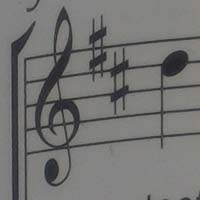 |
 |
|
|
ISO 100 (100% Crop) |
ISO 100 (100% Crop) |
|
 |
 |
|
|
ISO 200 (100% Crop) |
ISO 200 (100% Crop) |
|
 |
 |
|
|
ISO 400 (100% Crop) |
ISO 400 (100% Crop) |
|
 |
 |
|
|
ISO 800 (100% Crop) |
ISO 800 (100% Crop) |
|
 |
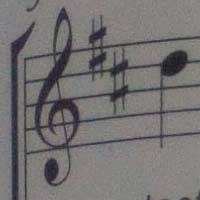 |
|
|
ISO 1600 (100% Crop) |
ISO 1600 (100% Crop) |
|
 |
 |
|
|
ISO 3200 (100% Crop) |
ISO 3200 (100% Crop) |
|
 |
 |
|
|
ISO 6400 (100% Crop) |
ISO 6400 (100% Crop) |
|
 |
 |
|
|
ISO 12800 (100% Crop) |
ISO 12800 (100% Crop) |
|
 |
 |
|
|
ISO 25600 (100% Crop) |
ISO 25600 (100% Crop) |
|
 |
 |
|
|
ISO 51200 (100% Crop) |
ISO 51200 (100% Crop) |
|
 |
 |
|
File Quality
Five quality settings are available: RAW, RAW+JPEG (Extra fine, Fine and Standard JPEG compression options), JPEG Extra fine, JPEG Fine and JPEG Standard. RAW files average around 24MB each, Extra Fine JPEGs roughly 15MB, Fine JPEGs are in the region of 7.5MB, and Standard quality JPEGs weigh in at approximately 5MB each.
| 24M Extra Fine (15.5Mb) (100% Crop) | 24M Fine (7.65Mb) (100% Crop) |
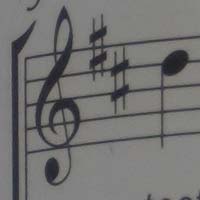 |
 |
| 24M Standard (5.25Mb) (100% Crop) | 24M RAW (23.9Mb) (100% Crop) |
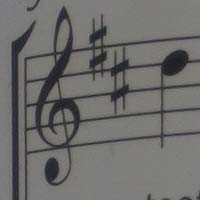 |
 |
Night
The Sony ZV-E10’s maximum shutter speed is 30 seconds, but sadly there’s no Bulb mode for even longer exposures. The shot below was taken using a shutter speed of 30 seconds at ISO 100.

Dynamic Range Optimizer
D-Range Optimiser (DRO) is Sony’s solution to improve shadow detail in photos taken in contrasty light. There are 5 different levels and an Auto option.
High Dynamic Range
High Dynamic Range Optimiser (HDR) is Sony’s solution for capturing more contrast than a single exposure can handle by combining two exposures into one image. There are 6 different EV settings and an Auto option.
Creative Styles
The Sony ZV-E10 offers 7 Creative Styles, which are sets of colour profiles for JPEG files only.
|
Standard |
 |
|
Vivid |
 |
|
Portrait |
 |
|
Landscape |
 |
|
Sunset |
 |
|
Black and White |
 |
|
Sepia |
 |
Picture Effects
The Sony ZV-E10 offers 13 Picture Effects, some with additional sub options: Toy camera (normal, cool, warm, green, magenta), Pop color, Posterization (mono, colour), Retro photo, Soft high-key, Partial color (red, green, blue, yellow), High-contrast mono, Soft focus (low, mid, high), HDR painting (low, mid, high), Rich-tone mono, Miniature (top, middle horizontal, bottom, left, middle vertical, right), Watercolor, and Illustration (low, mid, high).
|
Toy Camera |
 |
|
Pop Color |
 |
|
Posterization |
 |
|
Retro |
 |
|
Soft High-key |
 |
|
Partial Color (Red) |
 |
|
High Contrast Mono |
 |
|
Soft Focus |
 |
|
HDR Painting |
 |
|
Rich-tone Mono |
 |
|
Miniature |
 |
|
Watercolor |
 |
|
Illustration |
 |
Picture Profiles
|
Off |
 |
|
PP01 |
 |
|
PP02 |
 |
|
PP03 |
 |
|
PP04 |
 |
|
PP05 |
 |
|
PP06 |
 |
|
PP07 |
 |
|
PP08 |
 |
|
PP09 |
 |
|
PP010 |
 |
Sample Images
This is a selection of sample images from the Sony ZV-E10 camera, which were all taken using the 24 megapixel SuperFine JPEG setting. The thumbnails below link to the full-sized versions, which have not been altered in any way.
Sample RAW Images
The Sony ZV-E10 enables users to capture RAW and JPEG format files. We’ve provided some Sony RAW (ARW) samples for you to download (thumbnail images shown below are not 100% representative).
Sample Movies & Video
This is a sample movie at the quality setting of 3840×2160 pixels at 25 frames per second. Please note that this 15 second movie is 180Mb in size.
This is a sample movie at the quality setting of 1920×1080 pixels at 100 frames per second. Please note that this 15 second movie is 192Mb in size.
This is a sample movie at the quality setting of 1920×1080 pixels at 50 frames per second. Please note that this 15 second movie is 96Mb in size.
This is a sample S&Q slow-motion movie at the quality setting of 1920×1080 pixels at 120 frames per second. Please note that this movie is 128Mb in size.
Product Images

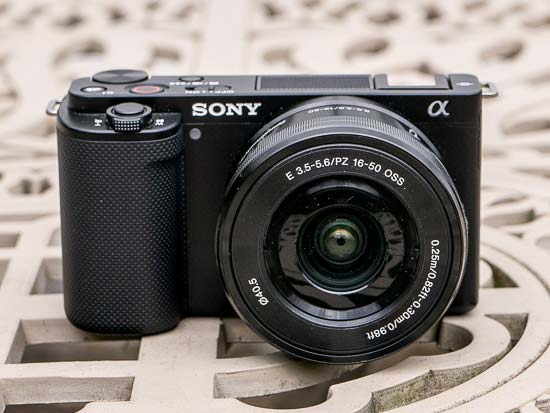
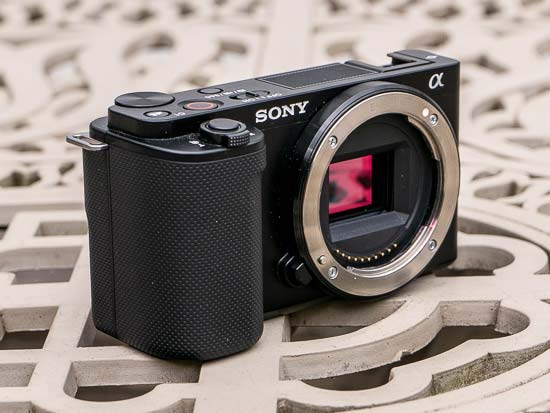
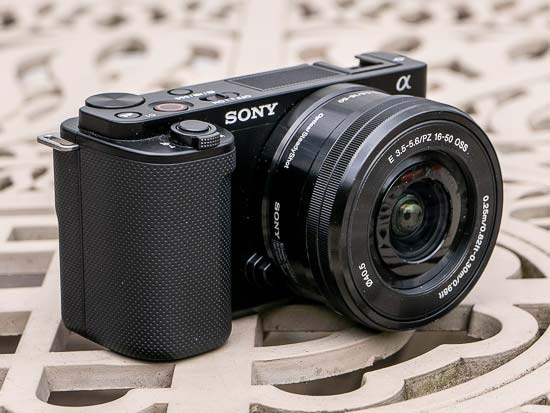
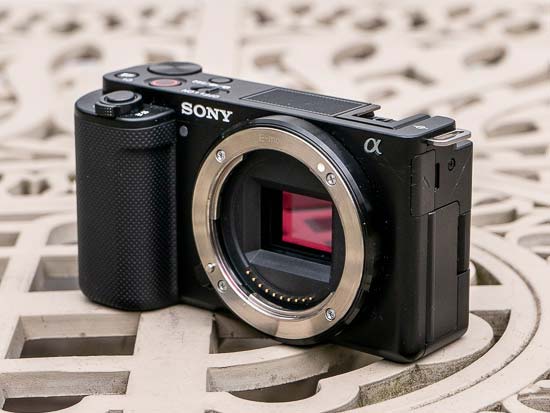

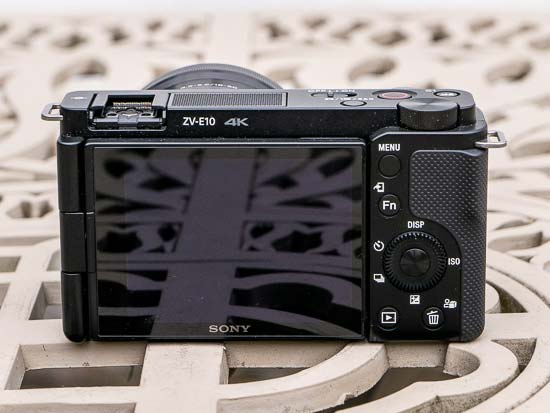
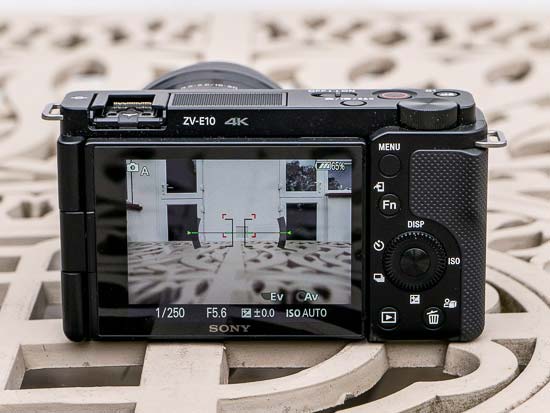



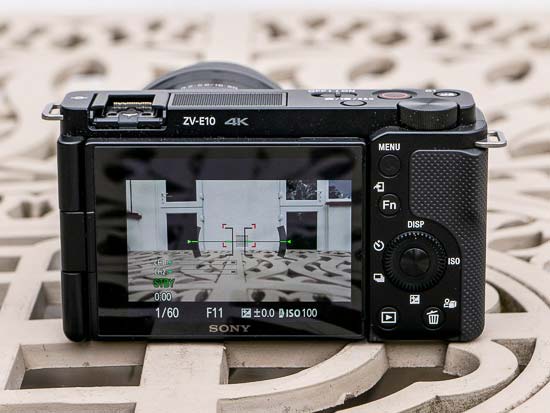

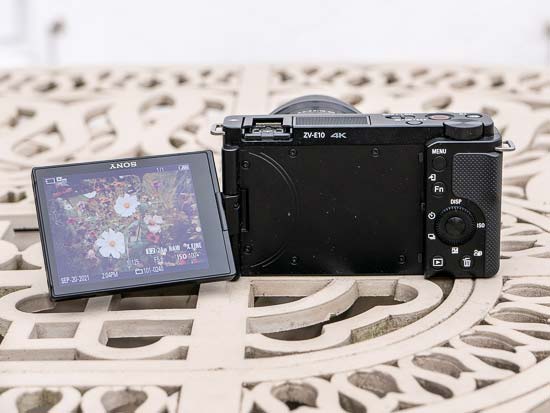
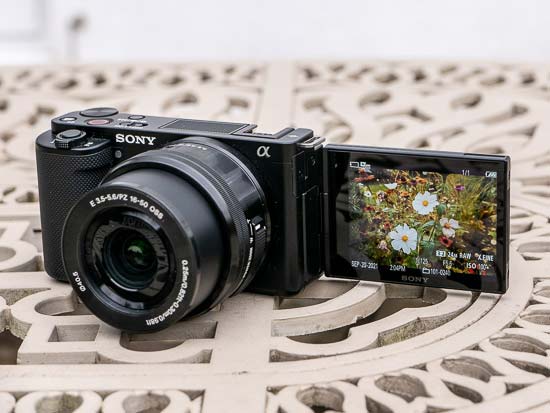


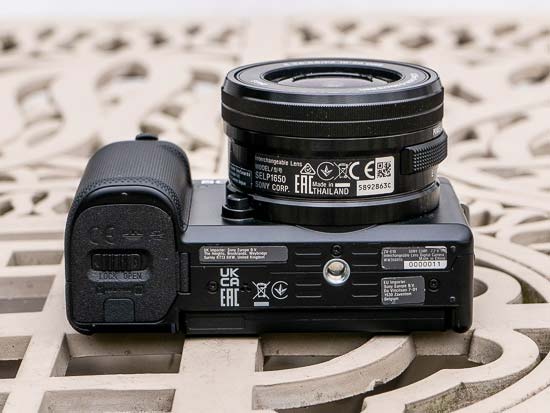
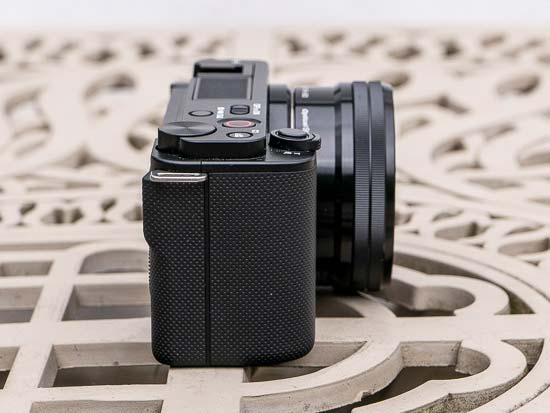
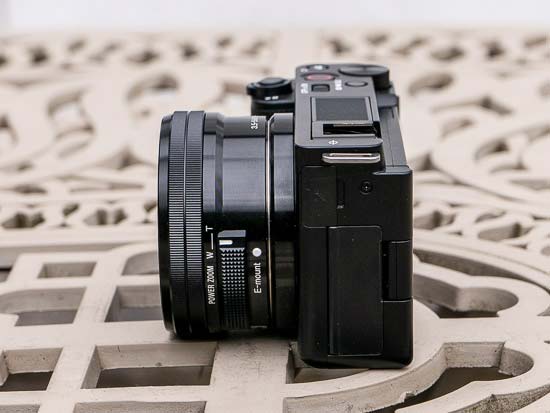
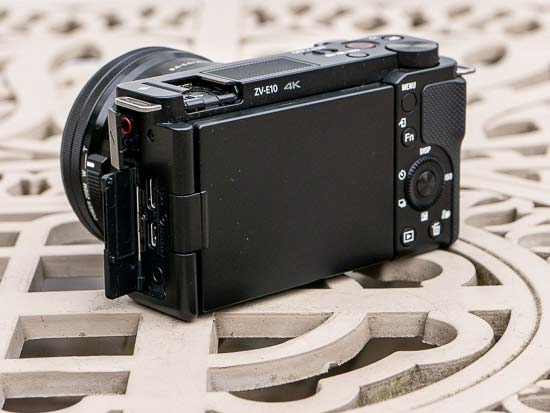
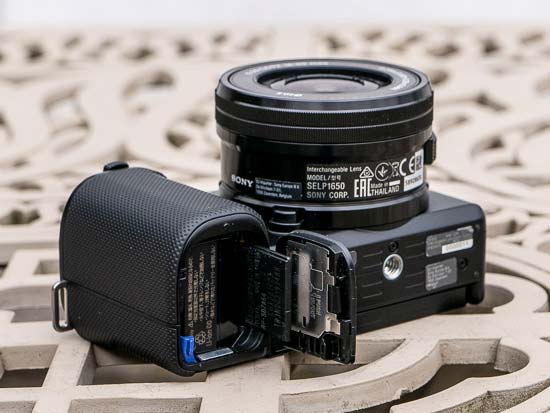


Conclusion
The ZV-E10 combines the best elements of the APS-C sensor A6xxx series cameras with last year’s ZV-1 compact camera to create a large-sensor, vlogger friendly camera that won’t break the bank.
It doesn’t get everything right (what camera does?) and is less well-suited to purely stills photographers than videographers, but is nevertheless well worth a look if video and vlogging is your main passion or if you’re a hybrid shooter.
An APS-C sensor camera for vloggers might seem like something of a niche proposition, but with 300 hours of video uploaded to YouTube every minute, not to mention Facebook, Instagram, TikTok, video content creation is going through a boom period in much the same way digital photography did in the early 2000s.
You can certainly get a creative edge using a camera like the ZV-E10 instead of your smartphone – you’ll be able to get a much more shallow depth of field look and low-light performance will be streets ahead – which may be good enough reason to justify adding an extra device to your kit bag.
The ZVE10 isn’t as easy to use for stills photography as the other A6xxx series cameras, but given that this is primarily a travel video camera that will be used as a significant upgrade to a smartphone, there shouldn’t be the need to constantly be changing settings like there would with a DSLR or mirrorless model.
Compared to the similarly vlogger-friendly ZV-1, the ZV-E10 provides the main benefits of a larger sensor and lens flexibility, but it does lack the ZV-1’s very useful built-in ND filter and its cutting-edge high-speed video modes, whilst being more expensive once you’ve factored in a lens (though not by that much).
At £770 / $800 with a lens, the price of the Sony ZV-E10 is actually surprisingly affordable, and given that many of the camera’s features are the same as found in recent A7 series models, there is certainly a lot of technology crammed into its very portable body.
Overall, the EV-E10 is a very decent first attempt at making Sony’s APS-C mirrorless camera range more video focused. Although it doesn’t offer anything genuinely new that we haven’t already seen elsewhere in their camera range, the combination of that large sensor with all of the vlogging features from the ZV-1 and the ability to use a vast array of different lenses is a pretty beguiling one.
| Ratings (out of 5) | |
|---|---|
| Design | 4 |
| Features | 4.5 |
| Ease-of-use | 4 |
| Image quality | 4.5 |
| Value for money | 5 |
Main Rivals
Listed below are some of the rivals of the Sony ZV-E10.
The EOS M50 Mark II is Canon’s newest entry-level mirrorless camera for 2021. With 4K/25p and 1080/60p video modes, a flippy LCD screen and a number of vlogger-friendly improvements, plus a 24 megapixel APS-C sensor, 10fps burst shooting and Canon’s excellent Dual Pixel AF system, could it be the perfect affordable camera for YouTubers, TikTokers and stills photographers alike? Find out now by reading our Canon EOS M50 Mark II review…
The Canon EOS M6 Mark II is a new mid-range mirrorless camera with a 32 megapixel APS-C sensor, 4K video recording, 14fps burst shooting, a tilting touchscreen and optional electronic viewfinder. Can it beat the likes of the Sony A6400 and Fujifilm X-T30 cameras? Find out now by reading our Canon EOS M6 Mark II review…
Want a tiny, lightweight 4K stabilised video camera that you can carry with you everywhere? Then look no further than the new DJI Pocket 2, which features a built-in gimbal with 3-axis motorised stabilisation in a body that weighs a mere 117g. Carry on reading our in-depth DJI Pocket 2 review, complete with full-size sample photos and videos, to find out what we thought…
Bridging the gap between complete photography beginner and more experienced enthusiast has often proved to be a tricky task for camera manufacturers. The new Fujifilm X-T200 aims to do exactly that, sitting between the entry-level X-A7 and the higher-end X-T30 in Fuji’s mirrorless camera range. Does it succeed in appealing to two quite different kinds of user? Find out now by reading our in-depth Fujifilm X-T200 review, complete with full-size sample images and videos.
Hot on the heels of the Sony ZV-1 comes another camera aimed directly at vloggers and Youtubers in the shape of the Panasonic Lumix G100. This time it’s a mirrorless interchangeable lens model, rather than a compact with a fixed lens. The tiny Lumix G100 also has a lot to offer stills photographers too – find out if it can make the grade in our in-depth review…
The much anticipated Panasonic GH6 may be on the near-horizon, but the brand new GH5 Mark II is here right now. What does the new version offer, and can it really improve on the best-selling original? We find out in our review of the Panasonic Lumix GH5 II mirrorless camera, complete with sample photos, test shots, videos and more…
The Sony A6100 is a new entry-level mirrorless camera that features the fastest auto-focusing system in the world. With a 24.2 megapixel APS-C sensor, 4K movie recording, a tilting OLED screen, electronic viewfinder and built-in flash, the Sony A6100 also offers 11fps burst shooting, bluetooth, wi-fi and NFC connectivity, and USB charging. Read our Sony A6100 review now to find out if it’s the perfect camera for photography beginners…
The Sony A6400 is a new mirrorless camera with an APS-C size sensor and a cutting-edge auto-focusing system. With 24.2 megapixels, 4K movie recording, a touchscreen 180-degree LCD touchscreen, 11fps burst shooting, electronic viewfinder, built-in flash, and Wi-fi / Bluetooth / NFC connectivity, is this the best APS-C camera on the market? Read our Sony Alpha A6400 review to find out…
The Sony ZV-1 is a new compact camera that’s been built from the ground up for vlogging, with a vari-angle screen, fast auto-focusing, three-capsule direction microphone, and a wealth of vlogger-friendly shooting modes. Is this the ultimate camera for aspiring YouTube creators? Read our in-depth Sony ZV-1 review to find out…
Review Roundup
Reviews of the Sony ZV-E10 from around the web.
The Sony ZV-E10 is a 24MP APS-C mirrorless interchangeable lens camera aimed at vloggers. It features an articulating selfie screen with touch capability, 4K video capture, headphone and microphone ports and a variety of add-on accessories to assist in video capture, including the handgrip seen in the photo above (sold separately) and a range of sophisticated microphones.
Read the full review »
The ZV-E10 is a very likeable little camera that doesn’t really break any new ground technically, and even ditches a few features that stills photographers would like to have, but for novice vloggers it’s a pretty good camera. It has 4K video, Sony’s excellent autofocus system, a vari-angle screen and a clip on muffler to cut wind noise. Best of all, against a backdrop of steadily climbing prices, it’s rather good value too. The lack of in-body stabilization and noticeable rolling shutter are downsides, though.
Read the full review »
The Sony ZV-E10 is a logical gap-filler in Sony’s lineup. A vlogging-focused camera with an articulating screen, boosted microphones, and a compact body, it’s a powerful little video tool and takes impressive photos. The ZV-E10 definitely isn’t perfect, with its three main limitations being significant rolling shutter when panning, a non-touch menu system, and no 4K capture at 60p (which isn’t common at the price). Get past those limitations though and you’ll find an affordable, video-focused hybrid with solid audio options.
Read the full review »
Your Comments



